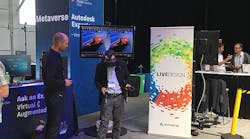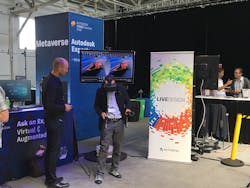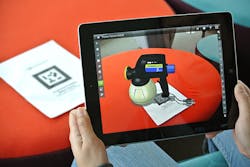What if you could interact with your CAD model? You sit all day at a desk designing a virtual object to be as close as possible to its physical counterpart and sometimes you will never understand how the part will fit once installed. Before, when I was a CAD jockey, I would design parts and never see them in person. They would be created and shipped off to the installation site. This sometimes would create headaches. Fit and form would be off or the installation hardware would be too short due to some change on the housing I was not aware of. This was one of the reasons I was excited to try the HTC Vive virtual reality headset at the Autodesk Forge DevCon earlier this summer.
There are two types of computer-generated simulation. The first is virtual reality (VR), where a person is completely immersed into a simulated world. Via the headset, their vision is completely replaced by the computer simulation that sometimes also affects their hearing or touch. Products like the Oculus Rift, the Samsung VR, and the PlayStation VR, along with the HTC Vive, are starting to be used by the gamer community, which feels like a natural fit. Using VR will completely immerse players into the gaming world. The headset is a bit jarring at first. You completely lose sight and perspective of your outside real surroundings (which is the point). Once the program is turned on, I was placed inside an apartment. With the two hand controllers, there are a variety of commands at your disposable. I could change the material of objects like the floor from wood to tile. I would also point at objects and move them around. One option gave me the power to teleport anywhere within the apartment, which caused me to almost fall when I jumped back after having teleported too close to an imaginary wall. The next program let me examine a race car. I was not able to drive the vehicle, but I was able to change the body, the color, and take a cross-section of the vehicle. While using the cross-section feature, wherever you place the control will be sectioned and you can move the control through the body of the car. This progressively reveals more of the internals of the car such as the engine and driving controls.
Augmented reality (AR) is an enhanced reality where the user can see and experience the world around them with the addition of computer simulation. Current AR uses a device like a smartphone or tablet to capture the surrounding environment via camera and place a digital effect. This effect is only viewable on the device being used to capture the surrounding area. AR has recently seen success with the Pokémon Go phenomenon. People around the world are using their smartphones to interact with the outside world.
Educational institutions and companies have been trying to implement VR and AR to understand their benefits. Both are being used in the classroom to help introduce students to complex parts and structures they would not see unless they were out in the field. Purdue University is currently working on VR research, specifically hand-feedback technology. This would allow the computer imaging software to capture actual hand movements that can interact with the CAD model. The potential of the device could result in an interface of tactile sensation between the engineer and the CAD model. Solidworks can currently use AR technology to display CAD models in real-world settings. This helps designers get a feel of their models in the actual environment.
After having experienced VR for myself, I am not sure of its current place in the engineering world. As an entertainment value, AR and VR are succeeding but I feel the uses are limited in engineering. You want your CAD model to interact with the outside world. Let us say you design a hydraulic pump that will be installed in a factory setting. The immediate concerns are, will this pump fit my layout (i.e., space restrictions, hydraulic hoses and lines matching up correctly, etc.) and secure mounting of installation hardware? To do this all virtually you would need to scan your current plant layout and then compare the CAD model to the virtual scan. This way you could view everything in a VR headset: your CAD model and your virtual factory scan. Using a tablet with an AR setting could also provide the same information. By overlaying the model into the install environment by using the tablet camera can provide measurements and fit checks. However, you would need to be there or have someone do it for you. The future of VR and AR is promising, but we are probably a few years away before it can be heavily implemented.



